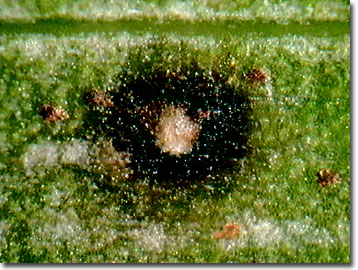Reflected Light Digital Image Gallery
Ornamental Palm Leaf
Palm trees, the symbol of the good life in the Tropics, can be brought into the household as potted, ornamental plants. Just as their big brothers along the beach or in the rainforest have preferred growing conditions, the proper light, moisture, soil, nutrition, and protection from disease are required for the indoor palm tree.

In many cases, the difference between inadequate and optimal light, and other growing conditions, makes a critical difference to the palm in an indoor environment. With optimal light, growth is better, diseases are almost non-existent, and the palm develops its true color and form. Too much direct light results in poor plant condition and leaf burning, while light of poor quality or insufficient intensity results in yellowing and premature senescence of palm tree leaves.
Adapted for sandy beach habitats, few palm species will tolerate heavy, cold, and wet soils, typical of temperate wetlands. If the soil in a container-grown palm will not dry out, the plant container should be placed in bright light and heated. In providing for ornamental indoor palms, soil pH and nutrition are usually not as critical as the avoidance of non-draining, cold soil. Consistent with their natural rainforest habitat, some palm species prefer heavy, infrequent watering rather than more regular, but lighter "rain" events. If the container lacks a drain hole, the plant will accumulate stagnant water and the roots will rot.
To mimic the natural temperature regime of the palm tree's habitat, subtropical and tropical plants should be maintained year-round between 62 and 88 degrees Fahrenheit, with lower temperatures at night. If the temperature is steady and cool, evaporation is retarded and the negative effects of cold, wet soil take their toll on the tree. Containerized palms are particularly susceptible to infestations by spider mites, especially if the air is hot and dry. However, these pest problems are treatable by using insecticides, or may even be preventable by regularly misting the leaves with water. Removing a fading leaf clasp to expose the bright new crown shaft is tempting, but only risks scaring, and the development of palm tree diseases. In some locations, the simple addition of a fan to assist in air movement greatly reduces the risk of molds and fungi that attack the palm fronds.
Contributing Authors
Cynthia D. Kelly, Thomas J. Fellers and Michael W. Davidson - National High Magnetic Field Laboratory, 1800 East Paul Dirac Dr., The Florida State University, Tallahassee, Florida, 32310.
BACK TO THE REFLECTED LIGHT IMAGE GALLERY
BACK TO THE DIGITAL IMAGE GALLERIES
Questions or comments? Send us an email.
© 1995-2025 by Michael W. Davidson and The Florida State University. All Rights Reserved. No images, graphics, software, scripts, or applets may be reproduced or used in any manner without permission from the copyright holders. Use of this website means you agree to all of the Legal Terms and Conditions set forth by the owners.
This website is maintained by our
Graphics & Web Programming Team
in collaboration with Optical Microscopy at the
National High Magnetic Field Laboratory.
Last Modification Friday, Nov 13, 2015 at 01:19 PM
Access Count Since September 17, 2002: 12394
Visit the website of our partner in introductory microscopy education:
|
|
